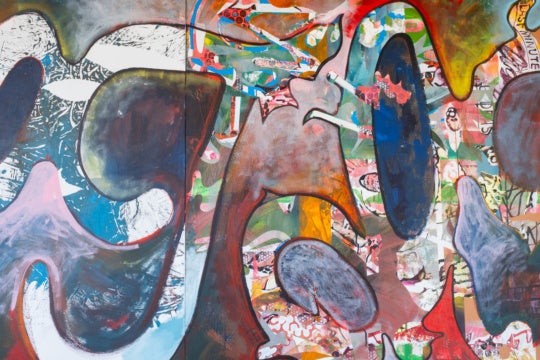
Like Cormac McCarthy’s novel Blood Meridian or the film Requiem for a Dream, Guatemalan artist Regina José Galindo’s exhibition at Vanderbilt University is masterful, but you might hesitate to recommend it because it’s like telling someone you’re going to show them something profound and beautiful, but first you have to kick them in the face. This show hurts.
Galindo is best known for performances that speak to the trauma of state violence in her home country and around the world. She completed a two-week residency at Vanderbilt in early November, during which time she invited Latino Nashvillians to join her in a public performance that took place only days after the election of Donald Trump, lending the already grim work an unexpected ominous quality. Galindo’s related video installation, Comunidad, is on view through December 9 at Space 204 in the E. Bronson Ingram Studio Arts Center on the Vandy campus, and here’s my short review: brutal.

The show has some people weeping in the gallery – I nearly did. It took me a week to process before I could begin writing this review. Galindo’s videos bear witness to horrors done to her indigenous community during the Guatemalan Civil War that raged between 1960 and 1996. During that time, government forces routinely raped, tortured, and murdered native Maya populations who were thought to be aiding the insurgency. Two million civilians were killed in the conflict, and the officers and officials responsible for these crimes have never been brought to justice.
This exhibition, which simply consists of four large projections in spaces separated by walls, offers a meditative environment in which the viewer can focus on the images and sounds of each video without distraction. Galindo’s images and scenes are intense and absorbing, making it the most moving exhibition I’ve seen anywhere is a very long time.
La Verdad (The Truth), 2013, is overwhelming in its visceral presence: Galindo sits at a table for more than an hour reading aloud through a litany of assaults, murders, and indignities Guatemalans endured for decades. The words are taken from accounts by eyewitnesses who survived these horrors. Galindo is interrupted several times by a man in dental scrubs and latex gloves who walks into the frame and reaches into Galindo’s mouth as she speaks and delivers a shot of Novocain from a huge syringe. By the end of the video, Galindo’s numbed mouth is speaking in a kind of listless murmur, but there is no mercy for her or the audience as her words are still discernible: “Soldiers discharge guns inside the vaginas of pregnant women while other women’s breasts are cut off before they slowly bleed to death. Soldiers gang rape a 12-year-old girl. A girl’s mother is held down and raped by soldiers … A man is decapitated.”
Language is the key element in La Verdad, but other videos offer more physical commentaries on the dark days of the civil war. In Quien puede borrar las huellas (Who can erase the traces), 2003, Galindo walks barefoot down a city street carrying a white ceramic basin filled with human blood. The artist systematically stoops to set the basin on the sidewalk and dips her feet in the blood before continuing her journey, leaving a trail of scarlet footprints. The original performance was a protest of the 2003 presidential candidacy of ex-dictator Effrain Rios Montt, who was celebrated by Ronald Reagan as being “a man of great personal integrity and commitment.”

Montt was acquitted of genocide and crimes against humanity, but the mass graves of those he “disappeared” tell a different story. In Tierra (Land), 2013, Galindo stands nude in a green pasture as an excavator digs a space out around her. The vulnerable, tiny artist juxtaposed with the dangerous tonnage of the loud machine tearing into the earth only feet away from her is a powerful metaphor for state militarism crushing a relatively defenseless population. It’s also a reenactment of how the actual mass graves were dug before victims were bayonetted and pushed into the deep muddy trenches.
For the 2007 performance of Confesión (Confession), Galindo put up a struggle in a brave performance that shows no signs of rehearsed choreography. The video opens in a barren cell with a large drum full of water in the center. Suddenly a door flies open and a massive man with a military haircut enters the room, dragging Galindo by the arm. He grabs her by the back of her neck and forces her head over the rim of the barrel and chest deep into the water. Gasping and coughing, she is dunked over and over until she’s finally hurled to the floor. With its clear demonstration of torture, this video protests the C.I.A.’s extraordinary rendition of suspected terrorists out of Palma de Mallorca in American custody.
I never responded to BURNAWAY’s request for a comment about the election of Donald Trump. A visit to Galindo’s exhibition confirms that America can be a dangerous and violent country. The horrors Galindo documents were supported by the U.S. and, in 1999, a report by the United Nations Historical Clarification Commission (CEH) found that the U.S. government and several American corporations were complicit in Guatemala’s Mayan genocide through the provision of training, arms, and financial aid. We might now be entering a period where America also projects such acts internally at marginalized groups. You might say that could never happen. But “never” doesn’t really mean what it used to anymore. I’m hoping for the best. I’m preparing for the worst.
Joe Nolan is a critic, columnist, and intermedia artist in Nashville. Find out more about his projects at www.joenolan.com.




